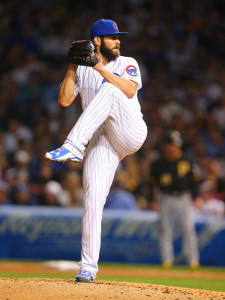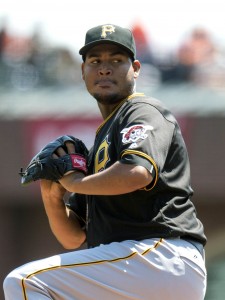By this point, the free agent market has thinned considerably, especially at its upper reaches. But there remain plenty of interesting players still available.
Looking through the list of unsigned players, one finds a number of recently high-performing pitchers who can likely be had on relatively (or very) modest deals. Achieving truly adequate pitching depth remains one of the game’s elusive pursuits, so there’s always opportunity for arms.
Here are some of the most intriguing names still available, featuring five starters and five relievers:
Tyson Ross: It came as a surprise when the Padres elected to non-tender Ross rather than paying him a repeat of his $9.6MM arbitration salary in his final season of eligibility, but that move leaves the 29-year-old available for other teams to take a risk. While organizations may prefer to attempt to secure multiple years of control if they roll the dice on the health of his ailing shoulder, Ross will no doubt prefer a single-season commitment. He carried a 3.07 ERA over 516 2/3 innings from 2013-15, so the upside is evident, and it’s no surprise that most of the league has some degree of interest.
Brett Anderson: Soon to turn 29, Anderson did not show well in his brief return from back surgery last year. But he turned in 180 1/3 frames of 3.69 ERA ball in 2015, and has generally been rather good when healthy, so there could still be something left in the tank. While Anderson’s extensive injury history is a major deterrent, organizations could reasonably hope that he can at least provide some useful innings during whatever stretch he is able to contribute.
Doug Fister: Entering his age-33 season after two straight duds, it’s tough to view Fister in quite the same light that one could have a year ago, when he seemed like a solid bounceback bet. That being said, he isn’t far removed from being a quality mid-rotation starter, and was at least able to turn in 32 starts in a healthy 2016 season. Unlike the other pitchers on this list, there isn’t an immediate injury to blame for the diminished value, though perhaps that also means he comes with a greater expectation of near-term contribution. If Fister can restore some of his lost groundball luster, perhaps he’d again rate as a useful rotation piece.
Nathan Eovaldi: Teams won’t be able to expect anything out of Eovaldi in 2017, as he’s expected to miss the entire year after Tommy John surgery. But he hasn’t even turned 27 and did show a personal-best 97.0 mph average fastball and 9.3% swinging-strike rate in 2016, so he remains an intriguing candidate to receive a rehab-and-return contract.
Henderson Alvarez: The long-term health outlook is perhaps even cloudier in the case of Alvarez, who couldn’t make it back to the majors in 2016 from shoulder issues. But he, too, has yet to reach his 27th birthday and he was able to provide 187 innings of 2.65 ERA ball as recently as 2014. And Alvarez did make 11 minor-league appearances last year, so there’s at least some reason to hope that he can contribute in the season to come.
Greg Holland: An obvious candidate for this list, Holland is perhaps the most fascinating relief arm still left unsigned. Once one of the game’s most dominant pitchers, the 31-year-old figures to sign with expectations of a full 2017 campaign after finishing up his TJ rehab. Like Ross, Holland has drawn wide interest and ought to be able to generate a variety of interesting and relatively lucrative opportunities.
Luke Hochevar: Now far removed from an impressive 2013 season in which he successfully transitioned from struggling starter to late-inning pen arm, Hochevar will be attempting to return from thoracic outlet surgery (after missing 2014 due to a Tommy John procedure). There’s plenty of uncertainty in the outlook for the 33-year-old, but he did put up 9.6 K/9 against just 2.2 BB/9 while working to a 3.86 ERA over 37 1/3 innings in 2016, and could be expected to return early in 2017.
Drew Storen: Still just 29, Storen was an electric reliever as recently as 2015, when he posted 11.0 K/9 and 2.6 BB/9 across 55 innings while working to a 3.44 ERA that metrics viewed as somewhat unfortunate. Though he struggled last year and showed a worrying drop in his average fastball velocity (from 94.1 mph in the season prior to 92.3 mph in 2016), Storen still put up a 10.5% swinging-strike rate that landed right at his career average. He also closed out the year by yielding just three runs in his final 17 innings while posting a 15-to-2 K/BB ratio.
Aaron Barrett: After TJ surgery derailed his sophomore 2015 season, Barret’s return was cut short with an elbow fracture. On the other hand, Storen’s former pen mate in D.C. owns a 3.47 ERA with 10.8 K/9 and 3.47 BB/9 over his 70 career MLB frames, with a 13.1% lifetime swinging-strike rate driven by his 93 to 94 mph heater and wipeout slider. Whatever team takes a shot on his future can also pick up plenty of affordable future control over Barrett, who’ll soon turn 29.
Charlie Furbush: Rotator cuff surgery is never good news for a pitcher, and returning from that procedure presents a major hurdle for the 30-year-old. But quality southpaws are always in high demand, so there’s much to be gained in the event that he can get back on track. Over his last 175 1/3 MLB frames, compiled over 2012 through 2015, Furbush provided the Mariners with a 3.23 ERA and 10.3 K/9 versus 3.0 BB/9.


